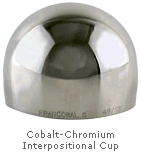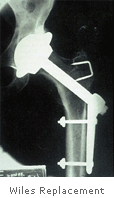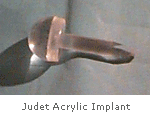Challenges to Creating Replacements That Work>>
Designing shape & structure>>
EARLY DESIGNS
1937 - Cobalt-Chromium Interpositional Cup
Interpositional cups were the forerunner of hip replacements. The idea that inserting a layer of material into an arthritic joint might prevent further deterioration dates back to the 1860s. Through the 1930s surgeons tried cups made of many different materials, such as glass and bakelite, but could not find a material that worked well.
In 1937, Marius Smith-Peterson inserted the first cobalt-chromium cup, which proved to be quite successful and was used for several decades. The technique fell into disfavour with the advent of total joint replacements, but is now being considered again, especially for younger patients.
|
 |

Copyright
Information
|
1938 - The First Total Replacement
Philip Wiles created the first total hip replacement, and implanted it in 1938. It was made of stainless steel and worked well in the short term.
Wiles' design had the basic elements of the modern hip replacement: a stem with a round head that fits into a cup. But instead of the stem going down the centre of the femur, the replacement was attached to the outside of the bone with a metal plate and screws.
This attachment method reduced the life span of the implant since the screws and plate tended to come loose or break with use.
|
1946 - First Acrylic Implant
The Judet brothers designed this hip replacement, made of acrylic, in 1943, and first implanted it in 1946.
Acrylic turned out to be an unsuitable material for joint replacements, since it cracked and broke with use. After this, almost all replacement designs used metal as the primary structural material.
|

Copyright
Information
|